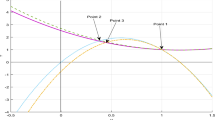Abstract.
The two-dimensional inviscid refraction of a shock wave at an oblique contact discontinuity is self-similar; i.e. it depends only upon the variables \(\xi\equiv x/t\), \(\eta\equiv y/t\). We transform the compressible Euler equations into the self-similar (\(\xi,\eta\)) coordinates and solve the resulting boundary-value problem by an implicit equilibrium flux method. We present results for strong shock (\(M\ge10\) where M is the incident shock Mach number) interactions with an oblique contact discontinuity separating an inert gas from a gas which exhibits high-temperature gas chemistry effects. To model high-temperature effects we employ Lighthill's ideal dissociating gas (IDG) model. Comparison between the frozen and equilibrium limits, both of which are self-similar, indicate large changes in peak density and temperatures. Significant differences in the overall flow pattern between the frozen and equilibrium limits are observed for interfaces with low negative Atwood ratio and high positive Atwood ratio. Results from a local analysis are presented when the shock refraction is regular. The critical angle at which the transition from regular to irregular refraction occurs is slightly larger for the equilibrium chemistry case.
Similar content being viewed by others
Author information
Authors and Affiliations
Additional information
Received 6 September 1996 / Accepted 20 May 1997
Rights and permissions
About this article
Cite this article
Samtaney, R., Pullin, D. Self-similar hypervelocity shock interactions with oblique contact discontinuities. Shock Waves 8, 299–310 (1998). https://doi.org/10.1007/s001930050122
Issue Date:
DOI: https://doi.org/10.1007/s001930050122




